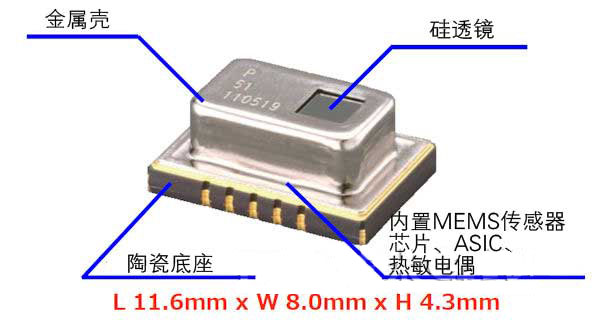Panasonic has developed an infrared array module sensor that can obtain an equivalent resolution of 7000 pixels by 8×8 pixels, and will provide a sensing system that can quantify the thermal sensation as an available original algorithm. It will be available starting from April 2016. It is assumed to be used in home appliances such as room air conditioners, in-vehicle equipment such as automobile air conditioners, and industrial equipment.

The appearance of the infrared sensor unit.
The new product swings the sensor at a finer pitch than one pixel, achieving high resolution. By synthesizing the images, high-resolution temperature distributions such as heat maps are obtained. According to reports, a high resolution of 7000 pixels can be achieved when the sensor is swung 180 degrees. The sensor uses a stepper motor to swing. The use of motor movement is only horizontal, but the sensor's pixels have an inclination of 7.1 degrees, so high resolution can also be achieved in the vertical direction. Compared to using a high-pixel sensor, the cost is lower. In addition, a clearer image can be obtained by adding an inverse operation to the optical blur caused by the lens.
Inferring hot and cold from non-contact on clothes
In terms of thermal sensation estimation, the heat dissipation calculated based on the temperature distribution information (thermal image) of high resolution is calculated based on the temperature difference between the body surface temperature and the ambient temperature. In general, the logic of judgment is that the more heat the person feels, the colder they feel, and the less heat the person feels the hotter. For example, when the dress is thick, the surface temperature of the clothes is low and the amount of heat dissipation is low, which means that the person feels very hot (warmth). On the contrary, when the clothes are thin, the surface temperature of the clothes is high and the amount of heat dissipation is high, which means that the person feels cold (cool).
In the past, when inferring thermal sensation, a method of detecting the skin temperature by applying a plurality of thermocouples on the body to calculate the amount of heat radiation was used. This time, the method is to calculate the heat dissipation in a non-contact manner from the clothes worn on the body. This method has a higher correlation with actual feeling than when estimating the thermal sensation from the heat amount calculated from the skin temperature.
Matsushita said that the algorithm for inferring thermal sensations from clothes on a non-contact basis is the first in the world. This method of inferring thermal sensation was jointly developed by Matsushita and Kubo Kozo, a professor of living environment at Nara Women's University in Japan. The basal metabolism of Asians such as the Japanese is different in summer and winter, and the amount of heat radiation changes. Improvements based on this point, for example, the calculation formula for inferring cold and hot sensations based on seasonal adjustments, can further improve accuracy.
The thermal inference system has been equipped with Panasonic's home room air conditioner products launched in October 2015. In terms of external sales, prototype evaluations are currently being implemented in customers and scheduled to begin sales in April 2016.
Panasonic previously sold "Grid-EYE" sensor cells. In the future, hardware and analysis software such as sensors and motors will be combined to provide sales of complete systems. By providing systems that include thermal and thermal inference applications, satisfy a wide range of customer needs.
At present, Panasonic is aiming at the market in the future and will develop products with twice the actual resolution by improving hardware and software. The inferred accuracy of hot and cold sensations will be further improved. This high-resolution product was first conceived for use in the automotive field, and is expected to be put into practical use by the year 2020. Below is a demo video of the system. (Reporter: Yuno Mako)
Model XLT-UTP-602 Waterproof Twisted Pair Transmitter is a transmission equipment that does not require additional Power Supply. The internal coils are three sets of wound high-density magnetic cores and compression-sealed to make the transmission effect more stable and the transmission distance. Farther, to prevent equipment damage caused by moisture. It uses a pair of twisted pair cables to transmit a single baseband video signal transmission device compatible with PAL, NTSC, SECAM baseband video compliance signals. Mainly used in security, teaching and other fields of high-definition AV signal passive twisted pair video transmission equipment.
In practical applications, we use two XLT-UTP-602 (matched into a pair) to use, which can transmit one video transmission distance of 0-500 meters, and the transmission distance of the twisted pair can reach 600 meters. The XLT-UTP-602 can also be paired with active receivers such as the XLT-UTP-301R, XLT-UTP-308R, and XLT-UTP-3016R with transmission distances of 600-800 meters. XLT-UTP-602 has strong interference suppression and anti-electromagnetic radiation capability, can be used in various complicated interference environments, and does not generate electromagnetic interference to the outside world. It is quite environmentally friendly and economical. At the same time, there are 4 pairs of lines in the five or more types of unshielded twisted pair. Each pair of lines can transmit one signal, which can transmit telephone, RS485 control data, audio, multi-channel video and even low-voltage power supply. Compared with the traditional video and audio transmission scheme, the passive twisted pair video transmitter can greatly reduce the cost and improve the performance. Compared with other similar products, the new Wright products have better performance, better stability and better cost performance. It is obvious.
UTP
UTP BNC, BNC UTP, UTP BNC Video, UTP BNC Video Balun
Shenzhen Wardmay Technology Co., Limited , https://www.wardmaycctv.com